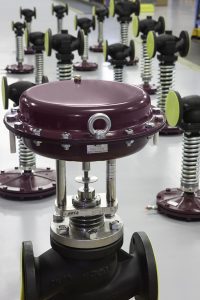At Winnellie Valve and Process, we supply quality Steam Products in a range of design types to suit all applications. We offer an extensive range of products for use in steam applications in the oil and gas, mineral processing, pulp and paper, power generation, food and beverage and pharmaceutical industries. These products include:


We also run training courses on Basic Steam Principles, Effective Condensate Removal and Steam Piping Principles. If any of these are of interest please contact us for more information.
If you’re unsure about which type of Steam Products you need for your application, or would simply like more information and guidance, Winnellie Valve and Process are only too happy to chat through your options with you.
Steam Valves are used to control or isolate the flow of steam from a source – such as a boiler – to its intended point of use and maintain the pressure / flow of the steam during the flow process.
Common types of Steam Valves include:
Ball Valves – which provide tight shut-off on low pressure / temperature applications only.
Globe Valves – which are linear motion valves with rounded bodies used to regulate fluid flow.
Y Pattern Globe Valves – which are used as an alternative for the high pressure drop inherent in standard globe valves.
Gate Valves – which are linear motion valves for isolation purposes only.
Control Valves – which are used to control fluid flow by varying the size of the flow passage as directed by a signal from a controller.
Parallel Slide Valves – which are used for providing isolation of flow in a piping system when closed.
Steam Valves are widely used in industrial applications. They are used in applications such as steam turbines to produce electricity, food and beverage manufacturing and for chemical and processes industries. They’re also used in steam applications for cleaning, heating and humidifying. Steam Pressure Reducing Valves are great at reducing the pressure of the outlet steam for process application. By controlling pressure, a steam valve also controls temperature as both steam pressure and temperature are related. To this day, steam remains a useful conveyor of heat energy. Therefore there continues to be a place for Steam Valves across industrial processes.
Steam Trap Types
There are two basic designs for the thermostatic steam trap, a bimetallic and a balanced pressure design. Both designs use the difference in temperature between live steam and condensate or air to control the release of condensate and air from the steam line.
Thermostatic or Bimetallic
In a thermostatic bimetallic trap it is common that an oil filled element expands when heated to close a valve against a seat. It may be possible to adjust the discharge temperature of the trap – often between 600C and 1000C. This makes the thermostatic trap suited to get rid of large quantities of air and cold condensate at start-up condition. On the other hand the thermostatic trap will have problems adapting to the variations common in modulating heat exchangers.
Float Steam Traps
In the float steam trap a valve is connected to a float in such a way that a valve opens when the float rises. The float steam trap adapts very well to varying conditions as is the best choice for modulating heat exchangers, but the float steam trap is relatively expensive and not very robust against water hammers.
Inverted Bucket Steam Trap
In an inverted bucket steam trap a leverage system multiplies the force provided by the bucket to open a valve against the pressure. The bucket is open at the bottom and robust against water hammers.
Thermodynamic Disc Steam Traps
The thermodynamic trap is a robust steam trap with simple operation. The trap operates by means of the dynamic effect of flash steam as it passes through the trap.
Steam Trap Surveys
On average, between 10% and 15% of steam traps fail every 12 months. This inevitably leads to unplanned downtime costing your operation both money and time. For this reason we recommend annual testing for all your steam traps to check for leaks, condition and general performance.
Should you require support in this area of your business Winnellie Valve and Process is available to assist starting with a basic walkthrough, right through to the use of ultrasonic, infrared and temperature measurement technologies to gather valuable data and identify any leaks, ineffective trapping and general energy loss. For more information on Steam Traps, or to sign up to one of our training services, please feel free to contact us today.
And for additional information on what type of Steam Valves or other Steam Products you require and tips on how to maintain your valve and process equipment, contact a Winnellie Valves and Process expert today.




You can also contact our trainer directly as per below contact details
e: Iain@winnellievalves.com
ph: +61 (0) 417 279 508

